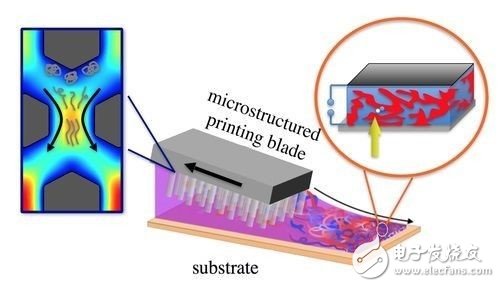A combination of many polymer polymers of a donor polymer and an acceptor can be used to form a complete plastic solar cell. Unfortunately, some of the best combinations tend to reduce the surface area of ​​electron transfer when they are brought together – from the donor (transfer electrons) to the acceptor (the electrons in the solar cell pass through to the solar powered device). . However, through a micron-scale "tweezers", these aggregates can be resolved and nanoscale crystals formed, which doubles the surface area and increases the output power by a factor of two.
The Institute of Materials and Energy Sciences (SIMES) at Stanford University in the United States calls this process "FLUENCE".
“We used donor and acceptor polymer materials – all-polymer solar cells, which used micron-sized tweezers for combing during coating to multiply the efficiency of the model system used,†said Professor of Chinese at SIMES. Bao Zhenan said.
Polymers are now generally chosen for all-plastic solar cells because the polymers are less likely to aggregate, even if the excitons produced are less likely to be aggregates. However, with this FLUENCE technology, solar cells can be used to realize the concentrating function of the polymer - the exciton (electron / hole pair) generated by each light unit, thereby optimizing the conversion efficiency and making the output power more traditional. The coating method is doubled.

Scanning electron microscopy (SEM) of a columnar upright 1 micron pitch "fluid-enhanced crystal engineering" or FLUENCE "tweezers"
“This micron-sized tweezers can be tuned to work with existing polymer formulations. However, depending on the polymer system used, the effect of the tweezers varies, but in the case where the polymer tends to aggregate into a large piece Most effective. It can be dispersed into small pieces using microscopic scales to achieve more efficient exciton dissociation," Bao Zhenan said.
Currently, these proof-of-concept dice experiments are being carried out at a very slow rate – about 3.5-14.2 inches per hour, and the most economical production with plastic solar cells requires a 50-inch per hour high-speed roll-to-roll (R2R) process. far cry. However, researchers are not worried about the challenge of speed, they say that this only needs to optimize the parameters - this includes choosing different solvent types to change the process temperature in order to upgrade the FLUENCE process to higher speed manufacturing.
“I think it is important to choose the right solvent and temperature in order to implement the advantages of this micron-sized tweezers,†said Bao Zhenan.
According to Bao Zhenan, in the past, microscopic straight knives were used to disintegrate these aggregates, but micro rafts were 18% more efficient, and it also allowed manufacturers to further increase the productivity of all-plastic solar cells. In fact, the researchers are very optimistic about this FLUENCE process, which allows plastic solar cells to show the efficiency of silicon-based solar cells with only a small part of the manufacturing cost.

Fluid Enhanced Crystal Engineering (FLUENCE) Solution
Mike Toney, head of the Stanford Synchrotron Radiation Source (SSRL) at the National Accelerator Laboratory (SLAC), used X-ray diffraction to measure the extent to which FLUENCE can separate donor and acceptor nanocrystals, and contributed to the research. In addition, the Advanced Light Source (ALS) of the US-based Lawrence Berkeley National Laboratory (LBNL) is used to demonstrate this technology.
Micron-sized tweezers are packaged at 1.2 micron pitch and are approximately 1.5 microns in height. Yan Zhou, a research fellow at Stanford University, optimizes the distance between the donor and acceptor crystals—making it close enough to achieve rapid electron transfer, but not so close that the receptor can return electrons after it has been collected. .
Others contributing to the program include former SLAC scientist Stefan Mannsfeld (now a professor at Dresden University of Technology in Germany), former SIMES postdoctoral researcher Ying Diao (currently a professor at the University of Illinois), and from ALS, Peking University and South Korea's Chengdu A group of scientists at the University of the University.
The US Department of Energy's (DoE) BRIDGE research program, the SLAC's Guided Research and Development Program Laboratory and the National Accelerator Laboratory, SIMES, and Stanford University all sponsor this funding.
Carbon fiber heating element
Such products are made of carbon fiber for the heating of the basic material made of tubular heating element, the use of reflective surface heat. The overall type of straight barrel and rectangular floor type: straight through the general use of single tube fever, the body can automatically rotate for the entire room heating. Turn on the power after the heating rate is surprisingly fast, in 1 to 2 seconds when the body has been hot, 5 seconds surface temperature up to 300-700 degrees, power in the 600 ~ 1200W adjustable. Rectangular floor type with double tube heat, you can floor or wall use, power is relatively large, in the 1800 ~ 2000W or so. In addition to heating function, these products can also play the effect of health care therapy. When the heating body heating can produce 765.9W / M of infrared radiation, the equivalent of a spectrum physiotherapy instrument.
Carbon Infrared Heater,Electric Carbon Infrared Heater,APG Carbon Infrared Heater,220V Electric Carbon Infrared Heater
Ningbo APG Machine(appliance)Co.,Ltd , http://www.apgelectrical.com